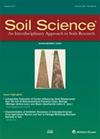How well does digital soil mapping represent soil geography? An investigation from the USA
4区 农林科学
Q2 Agricultural and Biological Sciences
引用次数: 4
Abstract
Abstract. We present methods to evaluate the spatial patterns of the geographic distribution of soil properties in the USA, as shown in gridded maps produced by digital soil mapping (DSM) at global (SoilGrids v2), national (Soil Properties and Class 100 m Grids of the USA), and regional (POLARIS soil properties) scales and compare them to spatial patterns known from detailed field surveys (gNATSGO and gSSURGO). The methods are illustrated with an example, i.e. topsoil pH for an area in central New York state. A companion report examines other areas, soil properties, and depth intervals. A set of R Markdown scripts is referenced so that readers can apply the analysis for areas of their interest. For the test case, we discover and discuss substantial discrepancies between DSM products and large differences between the DSM products and legacy field surveys. These differences are in whole-map statistics, visually identifiable landscape features, level of detail, range and strength of spatial autocorrelation, landscape metrics (Shannon diversity and evenness, shape, aggregation, mean fractal dimension, and co-occurrence vectors), and spatial patterns of property maps classified by histogram equalization. Histograms and variogram analysis revealed the smoothing effect of machine learning models. Property class maps made by histogram equalization were substantially different, but there was no consistent trend in their landscape metrics. The model using only national points and covariates was not substantially different from the global model and, in some cases, introduced artefacts from a lithology covariate. Uncertainty (5 %–95 % confidence intervals) provided by SoilGrids and POLARIS were unrealistically wide compared to gNATSGO/gSSURGO low and high estimated values and show substantially different spatial patterns. We discuss the potential use of the DSM products as a (partial) replacement for field-based soil surveys. There is no substitute for actually examining and interpreting the soil–landscape relation, but despite the issues revealed in this study, DSM can be an important aid to the soil surveyor.数字土壤制图在多大程度上代表了土壤地理?一项来自美国的调查
摘要我们提出了评估美国土壤性质地理分布的空间格局的方法,如数字土壤制图(DSM)在全球(SoilGrids v2)、国家(soil properties and Class 100 m Grids of USA)和区域(POLARIS soil properties)尺度上生成的网格图所示,并将其与详细的实地调查(gNATSGO和gSSURGO)所知的空间格局进行比较。以纽约州中部某地区的表层土壤pH值为例说明了该方法。一份配套报告考察了其他地区、土壤性质和深度间隔。本文引用了一组R Markdown脚本,以便读者可以将分析应用于他们感兴趣的领域。对于测试用例,我们发现并讨论了DSM产品之间的实质性差异,以及DSM产品与遗留现场调查之间的巨大差异。这些差异体现在全图统计、视觉可识别的景观特征、细节水平、空间自相关的范围和强度、景观指标(香农多样性和均匀度、形状、聚集、平均分形维数和共现向量)以及直方图均衡化分类的属性图的空间格局。直方图和方差分析揭示了机器学习模型的平滑效果。直方图均衡化方法绘制的地物分类图差异较大,但景观指标变化趋势不一致。仅使用国家点和协变量的模型与全球模型没有本质上的不同,并且在某些情况下,引入了来自岩性协变量的伪象。与gNATSGO/gSSURGO的低值和高低值相比,SoilGrids和POLARIS提供的不确定性(5% - 95%置信区间)大得不切实际,呈现出明显不同的空间格局。我们讨论了DSM产品作为(部分)替代现场土壤调查的潜在用途。没有什么可以替代实际检查和解释土壤-景观关系,但是尽管本研究中揭示了一些问题,DSM可以成为土壤测量员的重要辅助。
本文章由计算机程序翻译,如有差异,请以英文原文为准。
求助全文
约1分钟内获得全文
求助全文
来源期刊

Soil Science
农林科学-土壤科学
CiteScore
2.70
自引率
0.00%
发文量
0
审稿时长
4.4 months
期刊介绍:
Cessation.Soil Science satisfies the professional needs of all scientists and laboratory personnel involved in soil and plant research by publishing primary research reports and critical reviews of basic and applied soil science, especially as it relates to soil and plant studies and general environmental soil science.
Each month, Soil Science presents authoritative research articles from an impressive array of discipline: soil chemistry and biochemistry, physics, fertility and nutrition, soil genesis and morphology, soil microbiology and mineralogy. Of immediate relevance to soil scientists-both industrial and academic-this unique publication also has long-range value for agronomists and environmental scientists.
 求助内容:
求助内容: 应助结果提醒方式:
应助结果提醒方式:


